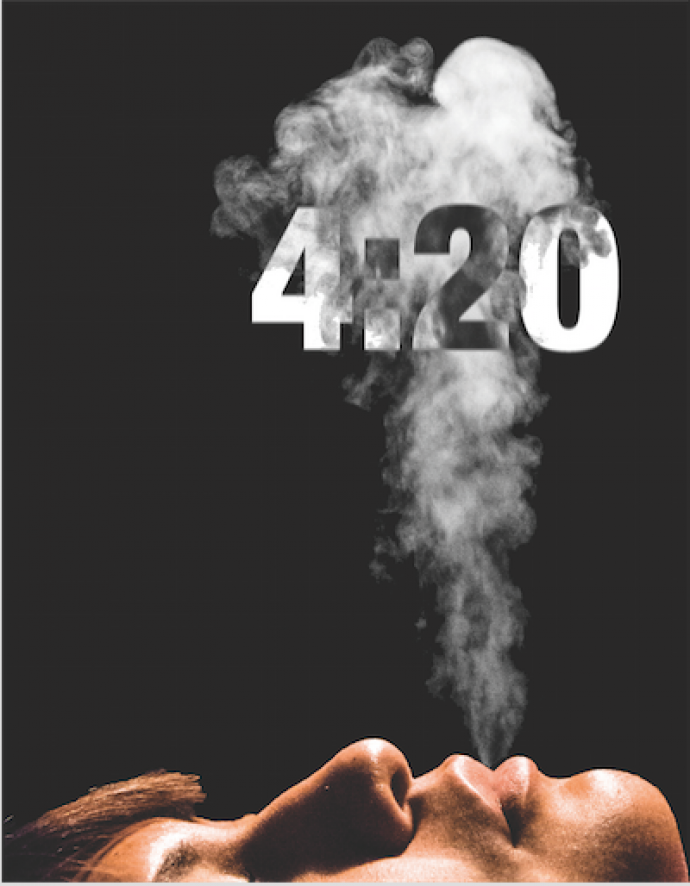So, these are the girls,” Andrew*, UTSA sophomore finance major says, gesturing to his collection of blowpipes. “They all have names — they’re all different. That’s Carmen; she was my first pipe,” he says pointing to a colorful blue and yellow swirled glass pipe.
“This is Medusa,” he says, picking up a long thin double-point blowpipe. “She was my second pipe. She’s a she-demon. One hit can turn a man to stone.”
Altogether, Andrew’s collection includes four blowpipes, an herb grinder, a blunt or two and a stash jar to hold his cannabis. Next to the pharmaceutical Rx symbol the label reads “For recreational use. Toke as needed.”
“I’m super nerdy about weed,” Andrew says.
Since the summer following his freshman year at UTSA, Andrew has smoked marijuana — though he prefers the more technical term “cannabis.”
He’s not alone in the use. The long-term Monitoring the Future project, sponsored by the National Institute on Drug Abuse (NIDA), conducted a national survey on drug use of college students between the ages of 19 to 55. In 2013, the survey revealed that 1 in 20 college students had near-daily marijuana use — the highest rate in the past three decades.
Out of the 20 people, Andrew is the smoking statistic.
A full-time student, who takes 15 hours and works two jobs, Andrew still finds time for near-daily marijuana use, usually in the evenings.
Marijuana has the infamous effects of being a mood-changer. Becoming happy, relaxed and open-minded: all reasons Andrew claims marijuana helps people more than it hinders them.
There are varying views of these “feel-good” effects. According to NIDA, marijuana causes “altered perceptions and mood, impaired coordination, difficulty with thinking and problem solving, and disrupted learning and memory.” All relatively negative-sounding effects that frequent marijuana users, such as Andrew, are trying to debunk.
You can usually find Andrew with his hair slicked back, wearing a nicely fitted button-down shirt paired with dark-wash pants and Warby Parker-style glasses. His looks do not correlate with a stereotype stoner — hoodie, red eyes, vapid speech and a look of dismay.
Andrew wants no association with the term “stoner.” He prefers to be referred to as a “cannabis enthusiast” or a person who considers marijuana use as a lifestyle, not just a hobby.
“The fact that I’m stigmatized because I happen to smoke marijuana is ridiculous,” Andrew says. “Cannabis is such a beautiful plant. The connections you can make with yourself — you find out a lot about yourself, you find out a lot about other people.”
The list of activities Andrew takes part in when he is high is extensive, impressive and sometimes worrisome. He does everything: clean his apartment, does laundry, talks to his parents or supervisor, waits tables, studies, attends to class, takes tests or quizzes and even drives.
Describing a simple activity such as reading for a marketing class, he explains that “with weed, or cannabis, everything is so much more fun.”
Besides enjoying the obvious effects of marijuana, Andrew has a deeply rooted motive for using marijuana. He suffers from anxiety and depression. Andrew has visited psychiatrists, counselors and has gone through the usual pharmaceutical route. Nothing works.
“There was a point my freshman year when I would have a panic attack two or three times a day, everyday. It was unmanageable,” Andrew says. “So with bud [marijuana], it just helps. It makes me more relaxed. It helps me love me a little more.”
So how bad can marijuana be if it helps people like Andrew become a better version of himself?
Dr. Jennifer Sharpe Potter, an associate professor in the department of psychiatry and anesthesiology at the University of Texas Health Science Center (UTHSC), explains there are possible consequences to keep in mind when using marijuana. “Believe it or not there are a lot of people who run into problems.”
Potter explains that roughly 1 in 10 people who use marijuana will develop a substance use disorder — their marijuana use gets to a point where they’re not able to stop.
With help of a NIDA grant, Potter has been able to research treatments for marijuana use disorders.
Potter explains problems that have been associated with marijuana use occur when addictive signals begin. Spending more time thinking of, trying to get, or using marijuana; or knowing it’s causing physical or psychological problems but using it anyway are all warning signs of addictive behavior.
This is not to say that marijuana is either good or evil, but needs further analysis in terms of use, access, benefits and disadvantages. “There’s a difference between a law and science,” Potter says. “The law has determined that there’s a medical benefit, and we see marijuana being used medicinally, so we know it offers some pain relief.”
Legalization of marijuana isn’t enough to become a societal norm. As with any drug, the research process looks at all possible angles. “It’s a very intriguing plant…the difficulty is that there has not been enough research,” she says.
How can one of the most wildly debated topics of legalization in a country not be adequately researched?
“I think it’s money, but I also think it’s a cultural issue,” Potter says. “The U.S. government and our society have conflicting feelings about marijuana. And that has made it difficult.”
Potter explains that the legal aspect of marijuana use can be confusing to people. “There’s a difference between whether we legalize it or not and whether it’s addictive or not,” she says.
The road to legal marijuana use — medicinally and recreationally — is going to take time.
Marijuana studies are conducted in highly controlled environments. Growing the plant, determining the right dosage and how it affects certain people and certain health conditions, takes enormous amounts of time and money.
“It is so difficult to obtain marijuana for the purposes of research that we don’t know enough,” she says. Marijuana hasn’t been a national priority for research funding; therefore, scientists have been less willing to tackle the questions and research.
So what are the priorities?
According to NIDA’s Fiscal Year 2015 Funding Priorities Report, most of its funding is invested in HIV/AIDS research. Projects for prevention, treatment, understanding HIV/AIDS better and training future AIDS researchers are priorities on both a domestic and international level.
Comparing HIV/AIDS research to marijuana research, most would guess that marijuana wouldn’t have a fighting chance.
Which leaves Andrew, a person who believes he benefits from marijuana yet can’t legally obtain it in Texas, left playing the waiting game. With lack funding to support research, and a lack of research to support legalization, time may be his biggest enemy.
“Right now, I don’t even want legalization,” Andrew says. “If I could have decriminalization I’d be satisfied.”
According to the National Organization for the Reform of Marijuana Laws (NORML), marijuana decriminalization has been enacted in 18 states, so far. Marijuana possession in small doses is treated as a mere traffic violation and cannot include jail time. The citation, almost like a speeding ticket, is equivalent to a slap on the wrist.
“There are way too many people in jail for possession of cannabis,” Andrew says. “I know for a fact that a lot of people smoke. It’s [a societal norm] more like, ‘You don’t do that? You haven’t smoked?’”
Andrew raises a valid point.
According to the Monitoring the Future project sponsored by NIDA, 51 percent of college students try illicit drugs in their lifetimes. Of all the illicit drugs, marijuana has been the most used in the 34 years Monitoring the Future has tracked college students’ substance use.
Potter explains that, just like with alcohol, smoking marijuana is seen as the typical sort of risk-taking behavior for most young people. “If you talk to people in certain places in San Antonio, there’s a perception that it’s easier to get than alcohol,” she says. “It’s fairly inexpensive, all things considered, and there’s a network you can get it from.”
Alcohol — the other college drug — has seemed to bridge the gap between two people from different worlds.
“How many cases have you heard dealing with domestic violence, rape, murder and car crashes are associated with alcohol? A lot,” Andrew says. “The only thing I want to beat up when I’m high is a hamburger.”
Andrew doesn’t think that marijuana is completely innocent, though. “You can get high and be stupid, just like with alcohol — which is just like legalized poison — but this [cannabis] is a natural herb,” he says.
On this point Andrew and Potter find common ground.
“Alcohol is a toxin, it’s just a socially acceptable toxin,” says Potter.
But Potter’s view includes one very important, often overlooked, point.
“[With marijuana] The vast majority of people will light up or smoke it, or eat it and won’t have trouble — just like with alcohol,” Potter says. “Some people will have trouble, and those people will need treatment.”
The ongoing marijuana legalization debate seems never-ending or exhausted at times, but Potter claims that there is a silver lining. “It’s [legalization debate] has made a lot of people talk about marijuana use and how we feel about it.”
The debate may be the spark to further marijuana research and encourage a more informed public. Based on funding and the popular negative public opinion, though, the results may take time.
Despite the complicated and long road to marijuana use, Andrew remains optimistic. “With legalization, the ‘cannabis enthusiast’ vs. ‘stoner’ [cultures] will come into light,” Andrew says. “I kind of want to be in the forefront of that.”
*The student’s name in this article has been changed for confidentiality reasons.


